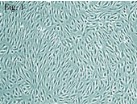
The brain microvascular endothelial cells are the major element of the blood-brain barrier and comprises the primary limitation to passage of substances, both soluble and cellular, from the blood into the brain. Brain microvascular endothelial cells utilize unique features that distinguish themselves from those of peripheral endothelial cells such as 1) numerous intercellular'tight junctions' that display high transendothelial electrical resistance and retard paracellular flux [1]; 2) absence of fenestrae and a reduced level of fluid-phase endocytosis [2] and 3) asymmetrically-localized enzymes and carrier-mediated Transport Systems that engender a truly 'polarized' phenotype [3]. Like peripheral endothelial cells, however, brain microvacular endothelial cells express cell adhesion molecules on their surface that regulate the extravasation of leukocytes into the brain. In view of the organ specificity of microvascular endothelial cells, endothelial cells should be derived from the tissue involved in the diseases one wishes to study.
